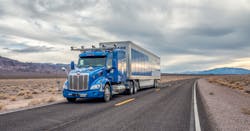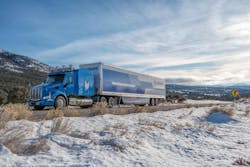Despite the recent lawsuit filed against self-driving truck systems maker Otto and its new owner, Uber, regarding the theft of autonomous vehicle trade secrets as well as the ongoing reluctance among both motorists and truckers regarding the acceptance of such technology, more than a few experts believe self-driving trucks will be a daily reality sooner rather than later.
The reason boils down to a single word: Economics.
“The autonomous vehicle is going to change everything,” Robert Hooper Jr., CEO of Atlantic Logistics, recently explained to me. “It’s a Tsunami coming at our [freight] industry and if we don’t prepare for it we’ll get swept away.”
[By the by, below is a look at the latest entrant to the autonomous truck field, Embark.]
An economist by training, Hooper said the cost-savings potential of the self-driving truck is huge, especially when one contemplates eliminating the need for a full-time human driver to pilot big rigs.
By his calculations, driver pay runs the gamut from $35,000 a year for those in drayage operations up to $125,000 annually for more “specialized” markets such as household goods moving and the like.
Now compare that to expected additional cost of self-driving systems to the base sticker price of a Class 8 truck, which this study said will be a around $23,400 per unit.
That’s a one-time expense per truck, compared to the ongoing pay required for a human, and obviously that comes in well below even the lowest wage rate on the truck driver pay scale.
“That’s why there will be a huge incentive to adopt this technology,” Hooper stressed. “That’s why I am trying to prepare my business for it.”
Still, despite that “incentive,” research by Steve Sashihara, founder and CEO of Princeton Consultants, indicates that “self-driving trucks” remains the one technological advancement most freight industry denizens are the most skeptical about.
“There are some people that believe no, this is definitely going to happen but there are a lot of other people that think in eight years; they’re not sure,” he explained. “Maybe we’ll see a few on the road but, I’m not sure it’s going to have a big impact.In Sashihara’s view, the potential safety benefit of autonomous vehicles as a whole – cars and trucks – is what’s going to driver their adoption.
“The Insurance Institute for Highway Safety (IIHS) did a very interesting report talking about live data on self-braking technology,” he explained. “Largely, the synopses which I’m seeing say that systems with automatic braking reduce rear-end crashes by about 40% on average. That would have been 700,000 fewer police reported rear-end crashes in 2013 and I think this is very important for the adoption [of self-driving vehicles].”
That’s but one reason he believes self-driving trucks “are close to inevitable,” but the question remains: where and when?
“In terms of tailwinds, [one] thing that is propelling [self-driving trucks] forward for long haul freight transportation is that approximately a third of the cost of truckload transportation are drivers [and the] constant of persistent long term driver shortages, from all quarters,” Sashihara pointed out.
“Also, very few trucks, in our experience, are slip-seated. A lot of them are ‘single-opted’ so, having something that isn’t bound by hours of service (HOS) means more asset utilization,” he added.
John Larkin, managing director and head of transportation capital markets research for Stifel Capital Markets, also thinks that self-driving trucks represents but the tip of a very large iceberg in terms of radical supply chain changes racing toward us.
“How long will it be before the internet of things (IoT) monitors the amount of granola each of us has in his/her pantry and records when the granola stockpile reaches the pre-specified replenishment level?” he asked.
“How long before 3D printers are placed in each of Amazon’s delivery vehicles so that the custom door handle you just ordered will be manufactured as it makes its way through your neighborhood en route to your front door?” Larkin added.
“How long before drones start delivering shaving cream to your front porch? Our sense is that all these innovations will be upon us sooner than we think – particularly if government would simply get out of the way.”
So hold onto your hats; we may be speeding toward the advent of true self-driving truck operations faster than we think.

